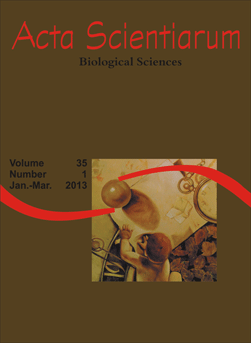<b>Photo-degradation effect on dissolved organic carbon availability to bacterioplankton in a lake in the upper Paraná river floodplain</b> - doi: 10.4025/actascibiolsci.v35i1.11054
Abstract
Dissolved organic carbon (DOC) is nowadays recognized as the main substrate and source of energy for aquatic microbial community. The great part of available organic carbon for bacterioplankton might be formed after photolytic degradation of humic material, which constitutes the major part of DOC in almost all natural waters. The effects of DOC photo-degradation were evaluated, as was its utilization by bacterioplankton, through a two-step experiment, one involving photo-degradation of DOC and the other bacterial growth on the photo-degraded substrate. Photo-degradation was responsible for the consumption of 19% of DOC, reduced SUVA254, an increase in the E2/E3 and E3/E4 ratios, in addition to modifications in the fluorescence spectra that indicated a rise in the labile fraction of DOC. However, these alterations on DOC were not reflected in differences in bacterioplankton growth, as shown by the fact that there were no significant differences in density, biomass, bacterial production, bacterial respiration and bacterial growth efficiency between treatment and control.
Downloads
DECLARATION OF ORIGINALITY AND COPYRIGHTS
I Declare that current article is original and has not been submitted for publication, in part or in whole, to any other national or international journal.
The copyrights belong exclusively to the authors. Published content is licensed under Creative Commons Attribution 4.0 (CC BY 4.0) guidelines, which allows sharing (copy and distribution of the material in any medium or format) and adaptation (remix, transform, and build upon the material) for any purpose, even commercially, under the terms of attribution.
Read this link for further information on how to use CC BY 4.0 properly.












1.png)




3.png)













